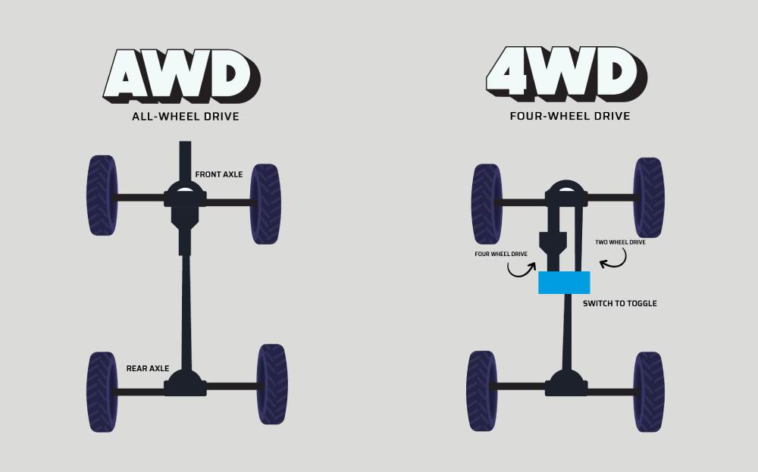Is AWD & 4WD Same Drivetrain? Hey, readers! As you all know that over time, the automobile sector has gained much knowledge and brought some amazing changes in itself. Where back in the time, we had manual windows opening and closing tradition that has now been replaced with power windows, and you can control your car’s windows just by pressing a button. The same thing happened with the engine start and off technique as there used to be a key system that needed to be inserted into the ignition and then it used to work.
That traditional key system has been replaced by a push start button that today you can turn your engine on or off just by pressing the key. The same thing happened with the drivetrains because in today’s time car makers have introduced advanced drivetrains options that deliver more power to the tires and keep it in control of the driver. However, the 4WD and AWD drivetrain is actually not available in every segment as it comes in some top-notch trims of different brands’ cars.
What Is AWD & 4WD In Cars?
So, when it comes to choosing a vehicle with enhanced traction and stability, terms like all-wheel drive (AWD) and four-wheel drive (4WD) are often thrown around. While they might sound similar, there are distinct differences between the two drivetrain systems. Understanding these differences can help you make an informed decision when purchasing a vehicle. In this article, we will explore whether AWD and 4WD are the same drivetrain and highlight the disparities between them.
AWD: Power Distribution for Enhanced Traction
When it comes to talking about the first topic then, All-wheel drive (AWD) is a drivetrain system that distributes power to all four wheels of a vehicle. It is designed to enhance traction on various road surfaces by continuously monitoring wheel slippage and redirecting power accordingly. AWD systems are typically found in passenger cars, crossover SUVs, and some high-performance vehicles.
Also, the primary function of AWD is to improve vehicle stability and control, especially in challenging driving conditions such as rain, snow, or loose gravel. By automatically transferring torque between the wheels, AWD provides better grip, reducing the chances of wheel slippage and improving overall handling. However, it should be noted that AWD is not intended for off-road use or extreme terrains.
4WD: The Ultimate Off-Road Capability
Apart from that the Four-wheel drive (4WD) is a drivetrain system commonly associated with off-road vehicles, trucks, and SUVs. Unlike AWD, which is typically engaged at all times, 4WD systems offer the flexibility to be manually activated or deactivated by the driver, depending on the driving conditions. 4WD systems excel in extreme terrains, such as mud, sand, or rocky trails.
When it comes to talking about the major difference then the main difference between AWD and 4WD lies in the distribution of power. In 4WD systems, power is usually split equally between the front and rear wheels. This even distribution allows for maximum traction and pulling power, enabling the vehicle to tackle challenging off-road obstacles. However, 4WD systems are less common in everyday vehicles, as they tend to increase fuel consumption and add weight to the vehicle.
Key Differences:
- Engagement: AWD systems are typically always active, automatically sending power to the wheels with the most grip. In contrast, 4WD systems are manually engaged by the driver when necessary, such as when encountering off-road conditions.
- Terrain Capability: While AWD is well-suited for on-road driving and light off-road use, 4WD is specifically designed for off-road adventures. The 4WD system provides the necessary traction and torque for conquering rugged terrains and steep inclines.
- Fuel Efficiency: Due to their constant operation, AWD systems consume more fuel than 4WD systems. The additional mechanical components in AWD vehicles add weight, resulting in increased energy expenditure. On the other hand, 4WD systems offer better fuel efficiency when they are not actively engaged.
- Vehicle Types: AWD is commonly found in sedans, crossover SUVs, and performance vehicles, offering improved handling and stability on various road surfaces. 4WD is more prevalent in trucks, SUVs, and off-road vehicles, catering to enthusiasts and those who frequently venture into challenging environments.
Finally, saying this won’t be bad that while AWD and 4WD may appear similar at first glance, they are distinct drivetrain systems with different purposes and applications. AWD systems provide enhanced traction and stability for everyday driving, while 4WD systems offer the ultimate off-road capability. Understanding these differences is essential when selecting a vehicle that suits your specific needs, whether it be commuting on paved roads or embarking on thrilling off-road adventures. Always consider your driving requirements and the terrain you will be traversing to make an informed decision between AWD and 4WD drivetrains.






GIPHY App Key not set. Please check settings